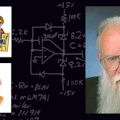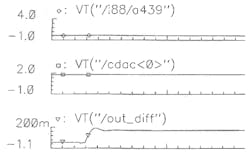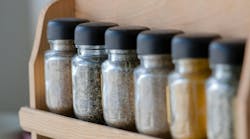Editor Note: This is a continuation of Bob's series on SPICE from Part 2.5, here
Recently, an engineer sent me his analysis of my current limiter, in "What's All This Current Limiter Stuff, Anyhow?" (Electronic Design, Sept. 5, 2000, p. 187), using a power MOSFET. He studied it and decided he did not like my optimization. So, he re-optimized it—using Spice. I studied his letter and replied.
I explained that he had not understood the functions of some of the diodes in the circuit. When he changed or removed a diode, the stress on the power MOSFET would be greatly increased, and I guessed that a factor of about 3 would cause great destruction and fireworks. (I thought about revising my working circuit to see if it would actually blow up when thus brutally stressed, but I decided that it wasn't worth the effort or aggravation.)
He replied, "But the Spice analysis shows the peak power on the FET was not too big." I just pointed out that the Spice analysis was probably not very accurate as to how many kilowatts would occur in that FET—for a few microseconds. Models (Spice models) for devices are not very accurate in high-power, high-current, or transient regions. I pointed out that when you actually buy a transistor, it is a pretty good model of the actual device and how much abuse it can stand. But a Spice model of the transistor is not.
Well, the engineer apologized for his (possibly) imperfect analysis of the circuit. But he observed that Spice was still a good tool for inexperienced engineers and students. "Spice may not be necessary, and is certainly not sufficient, but it does allow one to try 'what ifs' easily, and it does help considerably in understanding how circuits function," he said.
This got me mad: "I respectfully disagree: Spice takes away your ability to get good insights on what is happening. Spice actually HURTS your understanding of how circuits function."
Then he wrote, "What you must allow is that it takes much time (and you have the 'appearance' at least of having been around for ages!) for one to gain the experience of lots of designs. And if Spice can help, then I am all for it." And that is just my point! Building a circuit and blowing it up can help your design and engineering and learning process.
Building it in Spice does not help. And, I claim, using Spice will hinder your ability to design. An engineer should design as many things as possible, scribbling on the backs of envelopes, or modifying breadboards. Pretending that Spice is a substitute for that is an error! Pretending that Spice is even helpful is an error.
I mean, how are you going to learn to run a good marathon by hobbling around on crutches? Spice is a crutch. Sometimes Spice is a motorized crutch. And sometimes Spice is a rubber crutch. I've been around long enough to see Spice lie to me and my friends thousands of times—often seriously enough to force a major redesign of a circuit. And sometimes Spice tells you the wrong direction to go. Spice often tells you that a circuit won't oscillate. That's a lot of help, when you sit there and see it oscillating. After all, if doing Spice analysis is "necessary but not sufficient," and if you can't trust Spice anyhow because it is really not sufficient, why the heck bother with it? See associated figure:
Comments invited!
[email protected] —or:
Mail Stop D2597A, National Semiconductor
P.O. Box 58090, Santa Clara, CA 95052-8090
Editor Note: Part IV of this series is here.
About the Author

Bob Pease
Bob obtained a BSEE from MIT in 1961 and was a staff scientist at National Semiconductor Corp., Santa Clara, CA, for many years. He was a well known and long time contributing editor to Electronic Design.
We also have a number of PDF eBooks by Bob that members can download from the Electronic Design Members Library.







